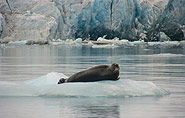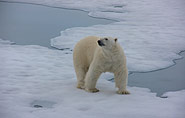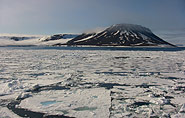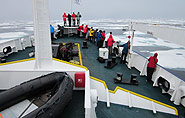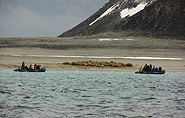North Spitzbergen Polar Bear Special
Day 1 - Arrive in Longyearbyen, the administrative capital of the Spitsbergen archipelago of which West Spitsbergen is the largest island. Before embarking there is an opportunity to stroll around this former mining town, whose parish church and Polar Museum are well worth visiting. In the surrounding area of Longyearbyen, more than 100 species of plants have been recorded. In the early evening the ship will sail out of Isfjorden, where in the mouth of the fjord we may see our first Minke Whale.
Day 2 – We sail to Raudfjord on the north coast of West Spitsbergen, a beautiful fjord dominated by spectacular glaciers and favoured by Ringed and Bearded Seal. The cliffs and shoreline of the fjord also support thriving seabird colonies and a surprisingly rich vegetation, which flourishes in sheltered spots. Polar bear are often seen here.
Day 3 - Depending on the weather we may now sail to the mouth of Liefdefjorden and go ashore for a walk on the tundra island of Andøya. Many Common Eider and Pink-footed Goose nest here, and the rarer King Eider may also be seen. We hope to sail into Liefdefjorden, cruising near the 5km long face of the impressive Monaco Glacier. The waters of the glacier front are a favourite feeding spot for thousands of Kittiwake. As well, Polar Bear have been seen on the glacier, providing wonderful opportunities for photography.
Day 3 - Depending on the weather we may now sail to the mouth of Liefdefjorden and go ashore for a walk on the tundra island of Andøya. Many Common Eider and Pink-footed Goose nest here, and the rarer King Eider may also be seen. We hope to sail into Liefdefjorden, cruising near the 5km long face of the impressive Monaco Glacier. The waters of the glacier front are a favourite feeding spot for thousands of Kittiwake. As well, Polar Bear have been seen on the glacier, providing wonderful opportunities for photography.
Day 4 - Today we will sail into Hinlopen Strait, home to Bearded Seal, Ringed Seal, Polar Bear, and Ivory Gull. At the entrance there is the possibility to see Blue Whale. We’ll navigate the ice floes of Lomfjordshalvøya in our zodiacs and explore the bird cliffs of Alkefjellet with thousands of Brünnich’s Guillemot. On the east side of Hinlopenstrait, we’ll attempt a landing at Palanderbukta on Nordaustlandet, home to reindeer, Pink-footed Goose, breeding Ivory Gull, and Walrus.
Day 5 – We will try reach our northernmost point at Phippsøya, in the Seven Islands north of Nordaustlandet. Here we will be at 81 degrees north, just 540 miles from the geographic North Pole. Polar Bear inhabit this region, along with Ivory Gull. The ship may sit for several hours in the pack ice, before turning west again.
Day 6 - Retracing our route westwards, our route takes us through and along the pack ice, keeping watch for Polar Bear and the elusive Greenland Whale (Bowhead). About 100 nautical miles west of Spitsbergen we sail along the edge of the continental shelf, where Fin Whale forage in summer in the upwellings along the Spitsbergen banks. West of the mouth of the Kongsfjord we have also good chances to see Humpback Whale.
Day 7 - We land at the northern tip of Prins Karls Forland near Fuglehuken, where Barentsz probably set foot on Spitsbergen for the first time. Seabirds nest on the cliffs, and along the coast we see Harbour Seal, the only population found in Spitsbergen. Here we also will observe the remains of the Polar Bear hunting era, with demolished set guns and bear traps. At the opposite site of Forlandsundet at Sarstangen is a haul out place for Walrus. Alternatively we sail into St. Johns Fjord or south to the mouth of Isfjorden and land at Alkhornet. Seabirds nest on its cliffs and Arctic Fox search the cliff base for fallen eggs and chicks, while Spitsbergen Reindeer graze the relatively luxuriant vegetation. At nighttime we arrive in Longyearbyen.
Day 8 - We disembark in Longyearbyen, the administrative centre of Spitsbergen, for the flights south to Oslo and onward home.


